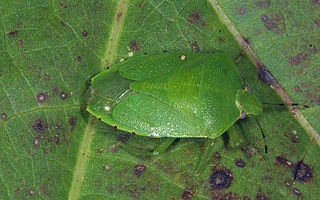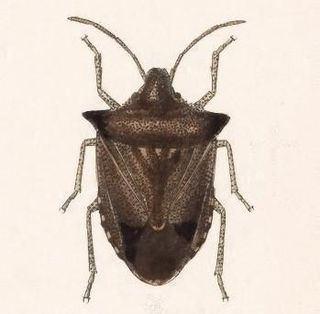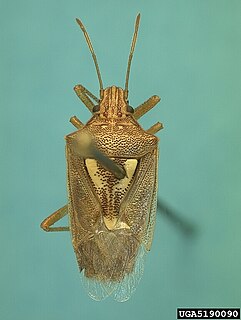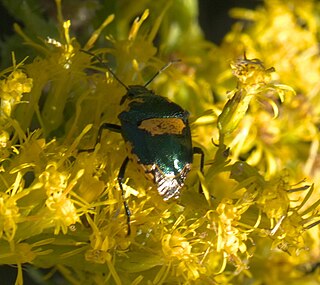
The Pentatomoidea are a superfamily of insects in the Heteroptera suborder of the Hemiptera order. As Hemiptera, they share a common arrangement of sucking mouthparts. The roughly 7000 species under Pentatomoidea are divided into 21 families. Among these are the shield bugs, giant shield bugs, burrower bugs, and stink bugs.

The green stink bug or green soldier bug is a stink bug of the family Pentatomidae.

The brown marmorated stink bug is an insect in the family Pentatomidae, native to China, Japan, and other Asian regions. In September 1998 it was collected in Allentown, Pennsylvania, where it is believed to have been accidentally introduced. The nymphs and adults of the brown marmorated stink bug feed on over 100 species of plants, including many agricultural crops, and by 2010–11 had become a season-long pest in orchards in the Eastern United States. In 2010, in the Mid-Atlantic United States, $37 million in apple crops were lost, and some stone fruit growers lost more than 90% of their crops. It is now established in many parts of North America, and has recently become established in Europe and South America.

Perillus is a genus of predatory stink bugs in the family Pentatomidae. There are about seven described species in Perillus.
Vulsirea nigrorubra is a species of stink bug in the family Pentatomidae. It is found in the Caribbean.

Mormidea lugens is a species of stink bug in the family Pentatomidae found in the Caribbean, Central America, and Eastern North America. In Illinois, adults have been observed emerging from overwintering sites in late April, and continue to be observed until early November, and appear to be bivoltine in this area. Eggs are approximately 0.7 millimetres (0.028 in) in diameter, pale yellow, and laid in small clusters of 6 to 11 eggs. Adults are bronze in color, with a white-yellow border around the scutellum, and are 5.0–7.2 millimetres (0.20–0.28 in) in length. In laboratory conditions, at approximately 24 °C (75 °F), development from eggs to adults has been documented to take between 39 and 50 days, and appears to be affected by the species of host plant. Mormidea lugens has been documented to feed on timothy, sedges, as well as deer-tongue grass, and Bosc's panic-grass. It has been collected from pale sedge and wide-leaved spiderwort but has not observed feeding on these species, and deer-tongue grass appears to be an insufficient food source for development.
Sciocoris longifrons is a species of stink bug in the family Pentatomidae. It is found in North America.

Euschistus is a genus of stink bugs in the family Pentatomidae. There are at least 20 described species in Euschistus.
Weda is a genus of turtle bugs in the family Pentatomidae. There are at least three described species in Weda.

Mormidea is a genus of stink bugs in the family Pentatomidae. There are about five described species in Mormidea.
Vulsirea is a genus of stink bugs in the family Pentatomidae. There are at least two described species in Vulsirea.

Chlorocoris hebetatus is a species of stink bug in the family Pentatomidae. It is found in Central America and North America.

Chlorocoris is a genus of stink bugs in the family Pentatomidae. There are about six described species in Chlorocoris.

Oebalus ypsilongriseus is a species of stink bug in the family Pentatomidae.

Oebalus is a genus of stink bugs in the family Pentatomidae. There are about six described species in Oebalus.

Carpocorini is a tribe of stink bugs in the family Pentatomidae. There are about 15 genera and at least 50 described species in Carpocorini.

Mecideini is a tribe of stink bugs in the family Pentatomidae. There is at least one genus, Mecidea, in Mecideini.
Moromorpha is a genus of stink bugs in the family Pentatomidae. There is one described species in Moromorpha, M. tetra.

Stiretrus anchorago, the anchor stink bug, is a species of predatory stink bug in the family Pentatomidae. It is found in Central America and North America.

Andrallus is a genus of predatory stink bugs in the family Pentatomidae. There is at least one described species in Andrallus, A. spinidens.











